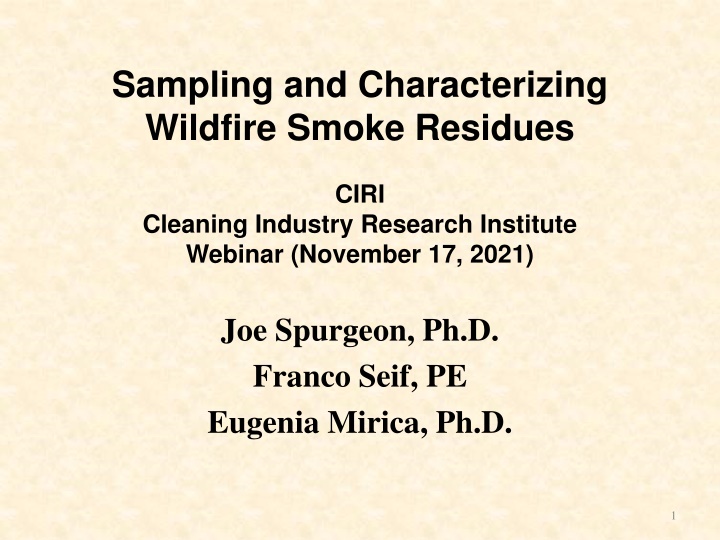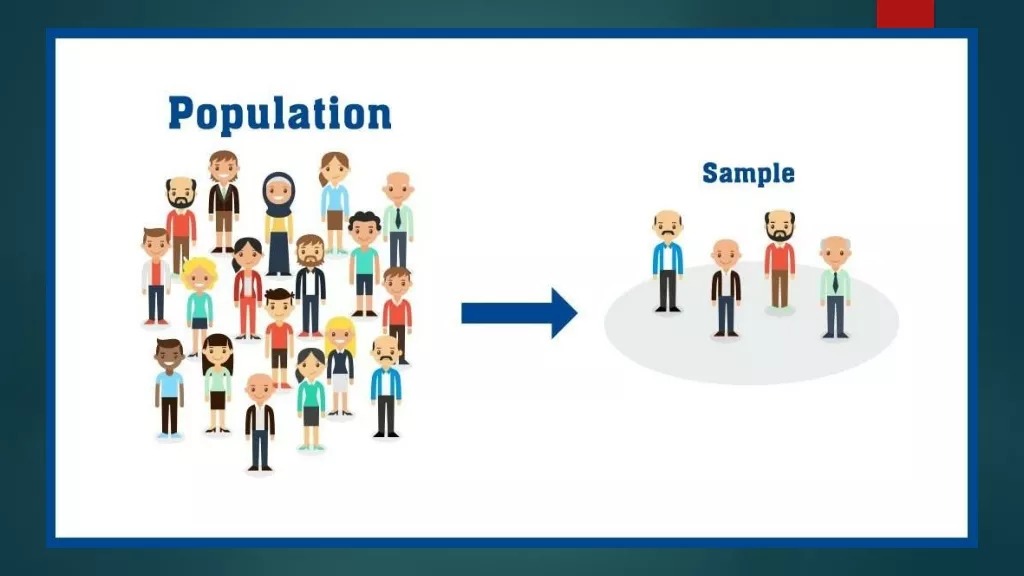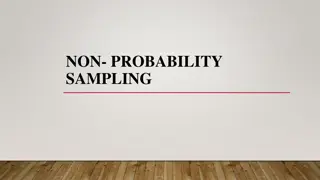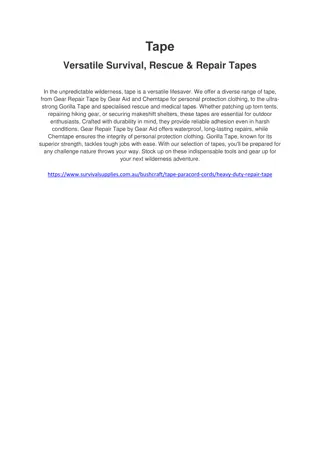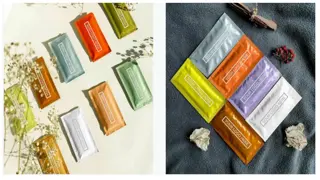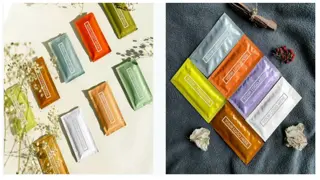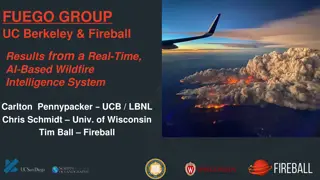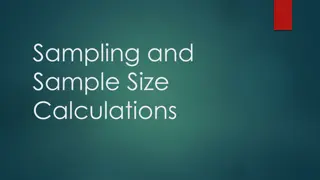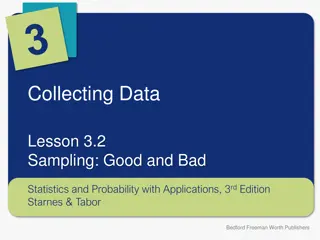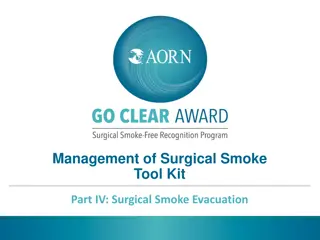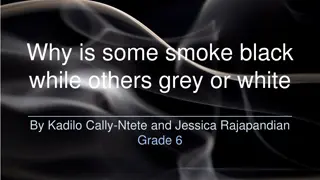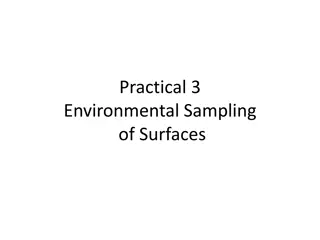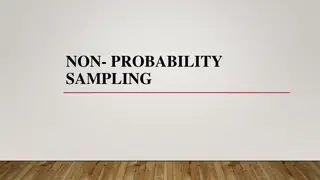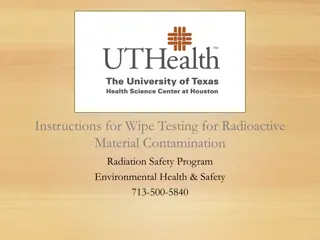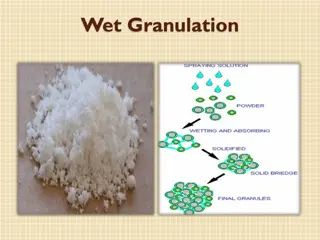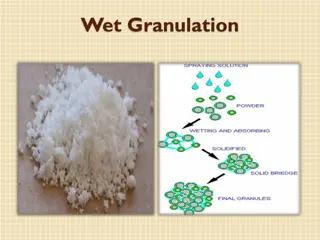Comparison of Wet-Wipe and Tape Lift Methods for Sampling Wildfire Smoke Residues
This research study compared the performance of wet-wipe and tape lift sampling methods for evaluating the impact of surface char from wildfire smoke residues. The study involved sampling 48 houses in Southern California affected by different wildfires, utilizing side-by-side replicate samples collected from interior window sills and hard surfaces. Samples were analyzed by EMSL Laboratories, revealing no detection of soot and ash. The results provided insights into the effectiveness of different sampling techniques in assessing wildfire smoke residues.
Download Presentation

Please find below an Image/Link to download the presentation.
The content on the website is provided AS IS for your information and personal use only. It may not be sold, licensed, or shared on other websites without obtaining consent from the author.If you encounter any issues during the download, it is possible that the publisher has removed the file from their server.
You are allowed to download the files provided on this website for personal or commercial use, subject to the condition that they are used lawfully. All files are the property of their respective owners.
The content on the website is provided AS IS for your information and personal use only. It may not be sold, licensed, or shared on other websites without obtaining consent from the author.
E N D
Presentation Transcript
Sampling and Characterizing Wildfire Smoke Residues CIRI Cleaning Industry Research Institute Webinar (November 17, 2021) Joe Spurgeon, Ph.D. Franco Seif, PE Eugenia Mirica, Ph.D. 1
Webinar Presentation (Expanded Slides) First Study Compare the relative performance of wet-wipe and tape lift samples for evaluating the impact of surface char from wildfire smoke Second Study Characterize several factors that can affect the evaluation of wildfire smoke residues 2
First Study* Assumptions Tape lift and wet-wipe samples are two commonly used methods for sampling wildfire smoke residues The choice of sampling method may affect the evaluation of the impact of wildfire smoke residues Objective Compare the relative performance of the wet-wipe and tape lift sampling methods for evaluating impact by collecting side-by-side (replicate) samples *Spurgeon J, Seif F, Mirika E; A comparison of the Wet Wipe and Tape Lift methods for Sampling Surface Char in Residential Properties Impacted by Wildfire Smoke; The Journal of Cleaning Science, Fall (16-24), 2021. 3
Description 48 houses were sampled in so. CA Affected by one of five wildfires Elapsed times between wildfire and inspection of 90 120 days Distances from wildfire to houses varied from less than 1 mile to 15 miles Two locations sampled in each house Perimeter location (Interior Window Sills) Interior locations (Interior Hard Surfaces) 4
Sample Collection Replicate (side-by-side) tape lift and wet-wipe samples Tape lifts 2x4 in BVDA tape Wet wipe 1x1 in BD alcohol pads Individual samples were collected from 3-5 spots Composited by the laboratory into 192 samples Interior window sills 48 tape lift and 48 wet wipe composite samples Interior hard surfaces 48 tape lift and 48 wet wipe composite samples Tables, baseboards, floors, dressers, bed frames 5
Sample Analysis Analysis by EMSL Laboratories Composited, sonicated, filtered, then analyzed Samples examined by stero-microscopy, reflected light microscopy, TEM/EDX, and SEM/EDX Soot and ash were not detected in any sample Laboratory confirmed this result was not unusual or specific to the wet wipe method Char analysis by polarized light microscopy (PLM) and concentration (%-char) reported using the Visual Area Estimation method Comparison of methods based on %-char 6
Detecting Char Windows Windows Interiors Wipe Tape 25 Interiors Tape CHAR <1% Wipe 25 30 34 Window sills Both methods did not detect char in the same 25 houses Interior hard surfaces Wet-wipe samples did not detect char in fewer houses (30) compared to tape lift samples (34) 7
EFFECTS OF SAMPLE PREPARATION Tape lifts and wet wipes performed the same on flat, relatively homogeneous surfaces INTERIOR WINDOW SILLS In the 23 houses where char was 1% or more on window sills, the results for the wet wipe and tape lift sampling methods were essentially the same for 22 houses Conclusion: Wipe sample preparation steps had no effect on performance 8
Assessing Impact Wipes performed better for collecting residue samples on interior hard surfaces INTERIOR HARD SURFACES In the 18 houses where %-char was 1% or more on hard surfaces, tape lift samples substantially underestimated the %-char in 11 of the hard surface samples (61%) 9
Dominant Concentration Ranges Windows Windows Interiors Wipe Tape 6 6 6 4 1 Interiors Tape CHAR 1% 2% 5% 10% >10% Wipe 6 7 5 4 1 3 2 8 2 3 11 4 1 2 0 For interior samples with a char concentration of 1% or more: Tape Lifts => 15 of 18 (83%) had %-char of 1%-2% Wet Wipes => 13 of 18 (72%) had %-char of 5% or more Wet wipes consistently detected higher concentrations of char 10
Comparison of Sampling Methods Wet-wipe samples performed better compared to tape lift samples for the purpose of evaluating the impact of wildfire smoke residues on interior hard surfaces Char was detected at a concentration of less than 1% in 63% of wet-wipe and 71% of tape lift samples The wet wipe sampling method detected higher levels of char, and in a higher percentage of houses 72% of wet wipes had a %-char of 5% or greater while 61% of tape lifts had a %-char of less than 3% 11
Preference for Sampling Methods Investigators must exercise professional judgment, evaluate the analytical methods available, consider the hypotheses in question, develop a sampling plan, and select a method that is appropriate to the situation, purpose of the study, and scope of work. [AIHA Wildfire Technical Guide] Supplied by Dr. Mirica, EMSL Laboratories: Percentage of Wildfire Samples submitted by clients FACILITY Wipes Tape Lifts Micro-vacs Cinnaminson 80% 10% 10% Pasadena 70% 25% 5% AVERAGE 75% 18% 7% 12
Second Study Characterization of Wildfire Smoke Residues 13
Objective Lot s of industry experience and knowledge, but difficult to find published documentation of that knowledge Objective Characterize the factors that can affect the evaluation of the impact of wildfire smoke residues Frequency of residue detection Distance from the wildfire Elapsed time since the wildfire Effect of sampling location Background concentration of char 14
Sample Collection 2,058 wet wipe samples were collected for Char, Ash and Soot Composites of 3-5 individual samples Samples were collected from 343 houses affected by 22 wildfires over a four year period (2017-2020) Sampling locations included Exterior surfaces Attic surfaces Interior window sills Interior hard surfaces Air return plenums 15
Prevalence of Wildfire Smoke Residues LOCATION SAMPLES (Positive) SAMPLES (%) CHAR ASH SOOT 368 37 4 17.9% 1.8% 0.2% Number of the 2,058 samples with a char Concentration (%-char) of 1% or greater 16
Primary Smoke Residue Conclusion: Char was the only wildfire smoke residue that was useful for evaluating impact in these studies Neither Ash nor Soot were detected with sufficient frequency to be useful for evaluating the impact of wildfire smoke residues Therefore, the following discussions were based on char concentrations (%-char) 17
Sampling Location Wildfire Smoke Residues Percentage of positive residue samples (=> 1%) in the 343 Houses LOCATION Window Sills Exterior Surfaces Interior Surfaces Attic Surfaces Return Plenums CHAR 39.7 % 38.5 % 14.3 % 9.0 % 4.4 % ASH 2.6 % 5.8 % 1.2 % 1.2 % SOOT 0.6 % 0.6 % Char was detected on interior hard surfaces In 148 (43%) of the 343 houses 18
Typical Char Concentrations Interior Windows 136 3.6% 8.0% 159% Interior Surfaces 49 4.2% 11.7% 164% Air Attics Exteriors Returns 15 1.9% 4.9% 182% Samples Median Average RSD* *Relative Standard Deviation 31 132 16.7% 23.2% 80% 13.9% 19.6% 83% 19
Sampling Location Variation of %-Char Positive percentages based on 343 samples per sampling location Exteriors Attics 61.5% 91.0% 0.3% 0% 7.3% 6.9% 23.5% %-CHAR <1% 1% 2% 3% - 5% >5% - 10% >10% Window Sills Interiors 60.4% 11.1% 11.1% 5.6% 0.3% 11.7% 85.7% 4.1% 3.8% 1.7% 0.0% 0.3% 2.2% 1.1% 5.4% 0% 3.8% Conclusions: 60%-90% of samples were less than 1% char Four apparent ranges of %-char for interior samples <1%, 1%-2%, 3%-10%, >10% 20
Sampling Location Average %-Char LOCATION Exterior Surfaces Attic Surfaces Interior Hard Surfaces Interior Window Sills Return Plenums AVG %-CHAR SAMPLES 132 31 49 136 15 23.2% 19.6% 11.7% 8.0% 4.9% Conclusion: Average %-char on exterior and attic Surfaces was about twice that on interior surfaces (20% v 10%) 21
Effect of Distance Hi-Lo-Avg for each distance Conclusion: No association between average %-char and distance from the wildfire for exterior surfaces; max %-char decreased with distance 22
Effect of Distance With so many wildfires, will cross-contamination be an issue? Conclusion: No association between average %-char and distance from the wildfire for interior window sills; max %-char decreased 23
Effect of Distance Percent of char samples detected by distance from the wildfire %-CHAR Samples One Mile Two Miles Cumulative % Exteriors Attics Windows Interiors 132 31 136 49 73.5% 74.2% 9.9% 16.1% 83.4% 90.3% 63.2% 8.8% 72.0% 67.3% 10.2% 77.5% 75% of interior char and 83% of exterior char samples were detected within two miles of the wildfire 24
Elapsed Time: Effect on Ash Exterior Surfaces Window Sills DAYS 30 60 90 ASH 10 11 % 48% 52% ASH 3 4 2 CUM % 33.3% 44.4% 22.2% Ash was only detected in the first 90 days Char continued to be detected over time, from 9 days through 1,270 days Conclusion: Char could be used to evaluate impact over a 3 year period; 95% of Ash samples were detected in the first 60 days. 25
Elapsed Time: Effect on Char Data were variable, but in general %-char decreased at different rates on different surfaces during the first 300 days 26
Elapsed Time Effect on Char %-char decreased at: 1.1% / month on interior window sills [Light cleaning] 1.3% / month on exterior surfaces [Weathering effects] 1.7% / month on interior hard surfaces [Occupant activities] Actual numbers can be variable, but order-of-magnitude estimates Conclusion: Elapsed time between the wildfire and inspection may be a confounding factor and should be considered when estimating original conditions 27
Consistency Between Sampling Locations LOCATIONS 1 / 6 2 / 6 3 / 6 4 / 6 5 / 6 HOUSES 95 58 30 13 3 PERCENT 28% 17% 9% 4% 1% Char was only detected in 1 of 6 sampling locations in 28% of houses; and in 2 of 6 locations in 17% of houses Sampling multiple locations was required to increase the probability of detecting char (Composite Samples) Conclusion: Composite samples were used to sample 3-5 locations cost-effectively. Results were simply averaged pre- rather than post-analysis. 28
Background Concentration of Char No consensus guidelines for background concentrations of wildfire smoke residues, HOWEVER The background char was less than 1% in 63% of the 48 houses and in 42% of the 343 houses for wet wipe samples The houses included in these studies were selected from houses potentially exposed to wildfire plumes So background concentrations of char were expected to be higher than in the general housing stock, not lower Therefore: Less than 1% char was a practical definition for background char in these two studies for wet-wipes, and was consistent with the data
Houses Subject to Restoration Percentage of the 18 impacted houses in the first study, based on interior hard surface results, that would be subject to restoration under the following assumptions Sampling Method Tape Lift Wet Wipe Wet Wipe Definition of Background Less than 3% Less than 3% Less than 1% Subject to Restoration 17% 72% 100% The choice of sampling method can have a substantial influence on evaluating the impact of wildfire smoke residues; and on the clean/restore decision 30
2011 Wildfire Study* 64 houses potentially exposed to a 2011 wildfire Distances from the wildfire were 6-60 miles Elapsed times were 3-8 months Wet wipe sampling method 1 BD alcohol pad 3 samples collected per house on interior surfaces Average %-char was reported for each house Composited samples after analysis (Research Study) * Ward T (2014) Evaluating the Use of Indoor Residential Wet Wipe Samples Following a Wildfire ; Intermountain Journal of Sciences; 20(1), 1-3 31
2011 Wildfire Study %-Char <1% 1% - 2% 3% - 5% >5% 64 Houses 22% 58% 11.1% 5.0% 32
Summary of 2011 Study Ash was not reported in any of the 64 houses, similar to the two studies of 48 and 343 houses %-char was less than 1% in 22% of the 64 houses compared to 42% in the later 343 house study Composite samples were reported to bean effective sampling method Sample results are typically averaged (composited) either before or after analysis 33
SAMPLING LOCATIONS Use of Similar Impact Areas* in Wildfire Inspections as Part of an Inspection and Sampling Strategy *Similar Restoration Areas 34
AIHA Exposure Assessment Strategy The AIHA EAS is based on Similar Exposure Groups (Similar Exposure Areas) Similar Exposure Area Similar in concept to IICRC Conditional Areas Six Samples YES NO PROFESSIONAL JUDGMENT STATISTICS Developed by British Occupational Health & Safety in the 1950 s Commonly used in Environmental Sciences and Industrial Hygiene 35
IICRC* Standard S520 for Mold *Institute of Inspection Cleaning and Restoration Certification Condition 1 Unaffected areas, normal conditions Condition 2 Areas affected by settled mold spores Condition 3 Areas subject to mold growth Is the same concept - Similar Impact Areas (SIA) useful (necessary?) for wildfire inspections? 36
343 Houses Exterior v Interior 61 houses with less than 1% char in Exterior Surface samples Essentially no char detected on 61 exterior surfaces, but char was detected in 54 interior window sill samples 13 interior hard surface samples Conclusion: Little association of %-char between exterior & interior sampling locations separate Conditional Areas %-CHAR Interior Windows Interior Surfaces <1% 12% 79% 1%-2% 72% 15% 3%-5% 12% 2% >5% 5% 5% 37
343 Houses INTERIOR WINDOWS SILLS - HARD SURFACES DIFFERENCES IN %-CHAR 100 30% of %-char on interior window sills and interior hard surfaces differed by 5% or more, and by as much as 90% Different Conditional Areas 50 Interior - Windows (%) 0 Conclusion: We should use caution when evaluating %-char (impact) by sampling just a limited number of sampling locations -50 -100 0 20 40 60 Rank Order Samples 80 100 120 140 38
Differences: Interior Surfaces Difference in %-char between interior window sills and hard surfaces DIFFERENCE (%) 1% 2% 3% 5% 10% 15% >15% SAMPLES 43 37 SAMPLES (%) 30.0% 25.9% 2.8% 13.3% 9.8% 7.0% 11% 4 19 14 10 16 Conclusion: We should use caution when evaluating %-char (residue impact) by sampling just a limited number of sampling locations [41% with 5% or greater difference] 39
Sampling Locations as Similar Impact Areas 149 houses in which char was detected on interior window sills or interior hard surfaces Could we predict %-char On Surface By Sampling Hard Surfaces Window Sills Attic Surfaces Window Sills Exterior Surfaces Window Sills Exterior Surfaces Attic Surfaces Could maybe do this if r = 0.9 or higher R-Value 0.23 0.17 0.37 0.21 IMPORTANT RESULT !! Conclusion: Could not use %-char from one sampling location to evaluate the impact of char for other sampling locations Six sampling locations were each separate Conditional Areas Each sampling location was an independent Similar Impact Areas 40
Sampling Transportation Accidents Continental Flight 3407 [2009] US Air Flight 1549 [2009] Amtrak, Fallon, NV [2011] Raytheon, El Segundo, CA [2011] 41
Items and Materials Tested in Transportation Fires Luggage Clothing Shoes & Belts Coats & Furs Electronics Jewelry Toys Hard plastics Soft plastics Synthetic fabrics Natural fabrics Wood Paper & Cardboard Glass & Metal Similar items as in a house fire
Fire Zones Are Impact Areas Fire Zones = Residue Impact Areas Items Tested Control Zone 1 Water Zone 2 Smoke Zone 3 Burn Zone 4 FIRE ZONE Area, Room, Box, Item* *Aircraft or Office Conclusion: Using the concept of Conditional Areas in fire sampling is not a new concept . I used Impact Areas for sampling transportation fires in 2009. 43
Combustion Particulate PCM Cassette Samples 6 pieces of luggage (Amtrak) Closed-face 25 mm cassette 0.8 um MCE filter % Char and Opaque [soot-like] particulate Direct PLM and SEM/TEM Analysis
Six Suitcases: Percent Soot Fire Zone 4 3 1 2% Conclusion: Fire Zones (Impact Areas) were associated with restorability, and return to initial condition
Wildfire Smoke Residues Alternative Wipe Samples Quartz fiber filters for sample collection Lab analysis using Mod EGA/TOR Method Report as Total Carbon, Organic Carbon, Elemental Carbon Can also reported as %-Char and %-Soot Cost range of $70-$125 per sample 46
Wildfire Smoke Residues Evaluation Ward (2011) concluded The wet wipe sampling method was useful for qualitatively assessing wildfire smoke impacts in indoor environments. Also applies to the tape lift method Microscopy method itself not sufficiently sensitive or accurate For example, difference between 3% & 5% char Lab reported 1%, 2%, 5%, 10%, 15%, 20% 47
Assessing Condition Total Carbon (OC/TC) using the EGA/TOR Method of Chin et al. Control, Restored, and Unrestored houses: three ranges of OC/TC Comparison of Tape Lifts for PRV assessment: No association HOUSE Control Control 1 2 3 4 5 6 CONDITION TC Char* Residential (Light Traffic) (US 1 Coast Highway Traffic) Walls painted (owner) Cleaned (owner) Cleaned (professional) Remodeled (owner) Contents (steam cleaned) Not restored 424 760 1,040 2,080 2,430 2,800 3,070 5,688 7% 5% 27% 8% 20% 14% *Char sampled by tape lift (PLM) 48
Ranges of %-Char for 199 Impacted Houses %-CHAR SAMPLES 1% 2% 3% - 5% >5% - 10% >10% Range >10% 15% - 80% 15% - 60% 15% - 90% Average %-Char for Interior Spaces Exteriors Attics Window Sills Interiors 132 0.8% 0% 19% 18% 61% 31 0% 3% 26% 13% 58% 136 28% 28% 14% 0.7% 29.4% 49 28.6% 26.5% 12% 0% 26.5% 15% - 99% %-CHAR HOUSES RIA * <1% 42% 1 1%-2% 56% 2 3%-10% 13% 3 >10% 28% 4 *SIA: Similar Impact Areas; same concept as the (2009) Fire Zones 49
Using Similar Impact Areas in Wildfire Inspections Using SIA as part of an inspection and sampling strategy Encourage the Inspector to define and use SIA Encourage inspection of each SIA Each SIA should be sampled if resources permit Use caution if estimating impact by sampling a limited number of SIA Composited samples should only be collected within each SIA All 3-5 samples from interior window sills, for example 50
